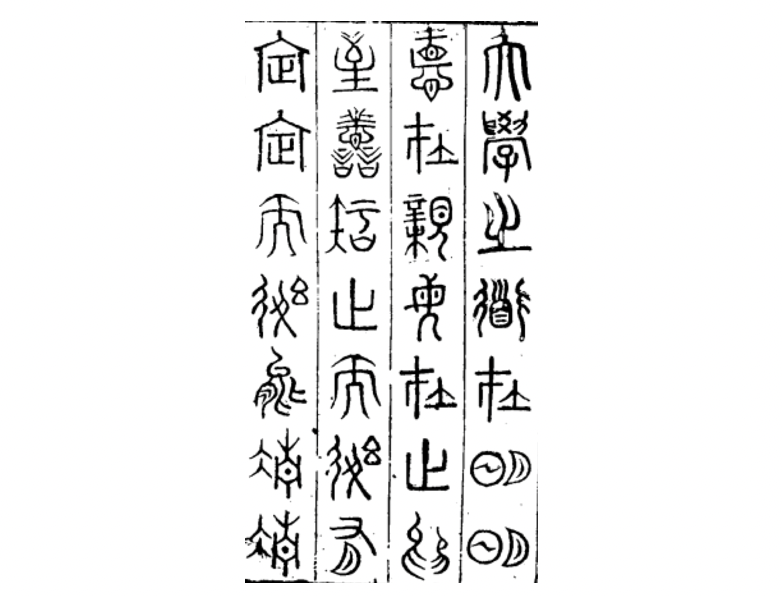Nathan Vedal, Ph.D. candidate in East Asian Languages and Civilizations and Fairbank Center Graduate Student Associate, explains how a Hollywood blockbuster about earth’s first contact with aliens echoes Neo-Confucian debates in the Ming Dynasty.

The 2016 blockbuster Arrival is unique among science fiction films on account of its heroine — a linguist who is assigned the seemingly impossible task of decoding an alien language. Without giving away too much of the plot, the linguist, Louise Banks as portrayed by Amy Adams, makes the decision to focus on the aliens’ peculiar writing system in order to decipher their language.
Ultimately what is accomplished in learning the written alien language is not merely a new mode of communication, but an entirely new way of thinking. While moviegoers may be incredulous at this premise, the idea that the language we speak can change the way we think is nothing new. Neo-Confucian scholars in the Ming dynasty (1368–1644) also believed that decoding an unfamiliar writing system could teach us new ways of seeing the world. Scholars in 16th century China argued that deciphering the ancient Chinese script from before the 5th century BCE was not only a key to unlocking the meaning of ancient texts, but also a way of learning to think like the ancient sages.
The form of Chinese writing that preoccupied many scholars in 16th and 17th century China was the ‘seal script’ (zhuan 篆) of the first thousand years BCE. In particular, they were interested in the version of this script purported to originate in the Zhou dynasty, as opposed to the standardized version of this script created under the order of the much-maligned and ruthless Li Si 李斯 (d. 208 BCE), Chancellor to the First Emperor of Qin. For Ming dynasty thinkers, restoring the writing system that predated the reforms of Li Si could improve the corrupt morals of the present. One 16th century scholar, in particular, named Wei Jiao 魏校 (1483–1543), promoted an approach to the ancient script that gained a strong following for the following 200 years. In his opinion, “The ancient script apprehended before me that which is common in my mind with everyone else’s.” As a result, by analyzing the composition of ancient characters, he argued, one could understand the “methods of the minds of the ancients.”

In practice, this meant parsing the components of an individual character to relay the moral message, which he believed the ancient sages had embedded in their creation of writing. For example, Wei explained the character for the word ‘obtain’ as containing two parts, one (見) meaning ‘to see,’ the other (手) meaning ‘hand.’ Wei derived this interpretation from an ancient character form. Historical interpretations of this character varied. Some identify this graph as containing the character for ‘shell’ (貝) rather than ‘to see.’ The logic behind this common explanation is that shells were employed as money in antiquity, and to have money in one’s hand represented the ability to ‘obtain’ things.

Wei Jiao provided an alternative explanation that he believed reflected the ancient sages’ understanding of the world. As he explained, what we see with our eyes may be misleading; we can only understand something concretely if we hold it in our hands. This notion that knowledge and action were united — that we can only understand something by doing it — was a central feature of the Neo-Confucian school of learning that Wei Jiao belonged to. In his view, the ancient writing system naturally embodied these philosophical truths.
While Wei Jiao’s method may seem eccentric today, it remained popular during and after his lifetime. His students wrote dictionaries which similarly maintained the premise that ancient writing conveyed ancient values. One influential if idiosyncratic thinker named Gu Yingxiang 顧應祥 (1483–1565), who approved of Wei’s method, wrote that “If today’s scholar can restore his misled mind while writing characters, causing each dot and stroke to have a precedent and not violate the ancient, then he will be very near the Way.” The study of characters in China involved a long history of correction, often according to a putatively ancient standard, to ensure that ancient texts were transcribed accurately. Gu’s argument is different; in his view, the practice of writing ancient characters itself was morally instructive.
Theories of linguistic relativism claiming that the language one speaks constrains the way one thinks occupied many 20th century linguistic debates. Posed even more strongly, could different languages bring us into different conceptual and behavioral realms? Chinese scholars in the 16th century believed we could attain moral perfection through a kind of osmosis, practicing the writing of the ancient sages. What does the heptapod language of Arrival have to offer for mankind? You will have to watch the movie to find out.
Nathan Vedal is a co-editor of the Fairbank Center blog. Read his post on How to Arrange Entries in a 16th Century Chinese Dictionary?


